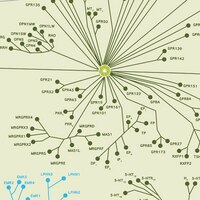HTS158M Sigma-AldrichChemiSCREEN™ Membrane Preparation Recombinant Human α1B Adrenergic Receptor
Human alpha1B GPCR membrane preparation for Radioligand binding Assays & GTPγS binding.
More>> Human alpha1B GPCR membrane preparation for Radioligand binding Assays & GTPγS binding. Less<<Prodotti consigliati
Panoramica
| Replacement Information |
|---|
Tabella delle specifiche principali
| Species | Host Cells | Protein Target |
|---|---|---|
| Human | Chem-1 | alpha1B |
| References |
|---|
| Product Information | |
|---|---|
| Format | Membranes |
| Presentation | Liquid in packaging buffer: 50 mM Tris pH 7.4, 10% glycerol and 1% BSA no preservatives. Packaging method: Membranes protein were adjusted to 1 mg/ml in 1 ml packaging buffer, rapidly frozen, and stored at -80°C |
| Quality Level | MQ100 |
| Physicochemical Information |
|---|
| Dimensions |
|---|
| Materials Information |
|---|
| Toxicological Information |
|---|
| Safety Information according to GHS |
|---|
| Safety Information |
|---|
| Storage and Shipping Information | |
|---|---|
| Storage Conditions | Maintain frozen at -70°C for up to 2 years. Do not freeze and thaw. |
| Packaging Information | |
|---|---|
| Material Size | 200 units |
| Transport Information |
|---|
| Supplemental Information |
|---|
| Specifications |
|---|
| Global Trade Item Number | |
|---|---|
| Numero di catalogo | GTIN |
| HTS158M | 04053252328619 |
Documentation
ChemiSCREEN™ Membrane Preparation Recombinant Human α1B Adrenergic Receptor MSDS
| Titolo |
|---|
ChemiSCREEN™ Membrane Preparation Recombinant Human α1B Adrenergic Receptor Certificati d'Analisi
| Titolo | Numero di lotto |
|---|---|
| CHEMISCREENTM MEMBRANE PREPARATION RECOMBINANT HUMAN a1B ADRENERGIC RECEPTOR - 2186725 | 2186725 |
Riferimenti bibliografici
| Panoramica dei riferimenti bibliografici | Codice d'identificazione nel Pub Med |
|---|---|
| Decreased blood pressure response in mice deficient of the alpha1b-adrenergic receptor. Cavalli, A, et al. Proc. Natl. Acad. Sci. U.S.A., 94: 11589-94 (1997) 1997 | 9326654
 |
| Myocardial expression of a constitutively active alpha 1B-adrenergic receptor in transgenic mice induces cardiac hypertrophy. Milano, C A, et al. Proc. Natl. Acad. Sci. U.S.A., 91: 10109-13 (1994) 1993 | 7937846
 |
Scheda tecnica
| Titolo |
|---|
| CHEMISCREENTM MEMBRANE PREPARATION RECOMBINANT HUMAN á1B ADRENERGIC RECEPTOR |









